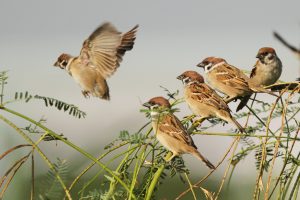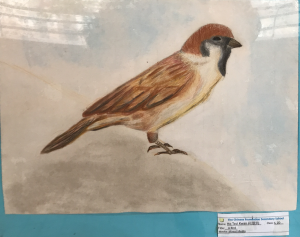| Common Name | (in English) Eurasian Tree Sparrow |
| (in Chinese) 麻雀 | |
| Scientific Name | (in Latin) Passer montanus |
| Peculiar characteristics / external features: | The Eurasian tree sparrow is 12.5–14 cm long, with a wingspan of about 21 cm and a weight of 24 g, making it roughly 10% smaller than the house sparrow. The adult’s crown and nape are rich chestnut, and there is a kidney-shaped black ear patch on each pure white cheek; the chin, throat, and the area between the bill and throat are black. The upperparts are light brown, streaked with black, and the brown wings have two distinct narrow white bars. The legs are pale brown, and the bill is lead-blue in summer, becoming almost black in winter. |
| Distributions: | The Eurasian tree sparrow’s natural breeding range comprises most of temperate Europe and Asia south of about latitude 68°N (north of this the summers are too cold, with July average temperatures below 12 °C) and through Southeast Asia to Java and Bali. It formerly bred in the Faroes, Malta and Gozo. In South Asia it is found mainly in the temperate zone. It is sedentary over most of its extensive range, but northernmost breeding populations migrate south for the winter, and small numbers leave southern Europe for North Africa and the Middle East. |
| Habits: | |
| Dietary | The tree sparrow is a predominantly seed and grain eating bird which feeds on the ground in flocks, often with house sparrows, finches, or buntings. It eats weed seeds, such as chickweeds and goosefoot, spilled grain, and it may also visit feeding stations, especially for peanuts. It will also feed on invertebrates, especially during the breeding season when the young are fed mainly on animal food; it takes insects, woodlice, millipedes, centipedes, spiders and harvestmen. |
| Reproductive (Solitary/Social/Territorial, Courtship Behavior, Taking care of youngs, etc) | Pairs may breed in isolation or in loose colonies, and will readily use nest boxes. In a Spanish study, boxes made from a mixture of wood and concrete (woodcrete) had a much higher occupancy rate than wooden boxes (76.5% versus 33.5%), and birds nesting in woodcrete sites had earlier clutches, a shorter incubation period and more breeding attempts per season. Clutch size and chick condition did not differ between nest box types, but reproductive success was higher in woodcrete, perhaps because the synthetic nests were 1.5 °C warmer than their wooden counterparts.
The male calls from near the nest site in spring to proclaim ownership and attract a mate. He may also carry nest material into the nest hole. The display and nest building is repeated in autumn. The preferred locations for the autumn display are old Eurasian tree sparrow nests, particularly those where nestlings had hatched. Empty nest boxes, and sites used by house sparrows or other hole nesting birds, such as tits, pied flycatchers or common redstarts, are rarely used for the autumn display. |
| Whatever appropriate | |
| Interesting Fact: | Hybridisation between the Eurasian tree sparrow and the house sparrow has been recorded in many parts of the world with male hybrids tending to resemble the Eurasian tree sparrow while females have more similarities with the house sparrow. A breeding population in the Eastern Ghats of India, said to be introduced, may also hybridise with house sparrows. |
References:
- https://www.beautyofbirds.com/treesparrow.html
- http://www.audubon.org/field-guide/bird/eurasian-tree-sparrow
- http://www.sialis.org/etsp.htm
Voice of Eurasian Tree Sparrow:
https://www.allaboutbirds.org/guide/Eurasian_Tree_Sparrow/sounds
Video:




